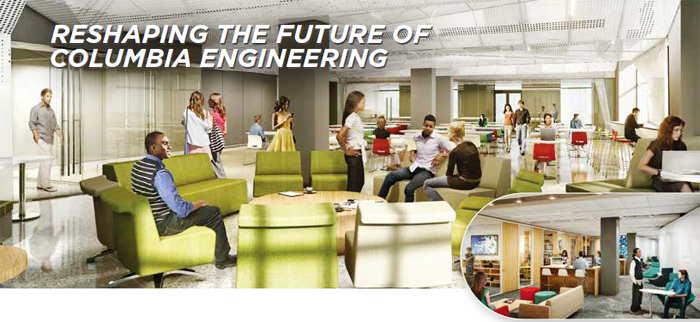Reshaping the Future of Columbia Engineering

In Mudd, a flurry of construction is already underway, beginning with the campus-level fourth floor of the building, which is undergoing perhaps the most dramatic change. The old Carleton Lounge and cafeteria are being transformed into the new Carleton Commons and Blue Java Café. Set to reopen in April, the reimagined space will comprise 2,800 square feet with seating for 160 and areas for casual meetings, individual and group work, and quiet study. The new student commons will also be readily reconfigurable for large gatherings.
With the opening of the Science and Engineering Library at the Northwest Corner Building, the former Engineering Library on the fourth floor of Mudd is being transformed to be home to the Columbia Data Science Institute (DSI). The facilities will serve SEAS DSI faculty members and more than 80 graduate students and postdocs, as well as provide communal space for collaborative research and study.
Other floors of Mudd are also getting revamped to better serve departmental needs, including major renovations to laboratory spaces for Biomedical Engineering and Electrical Engineering.
Adjacent to Mudd, in the Schapiro Center for Engineering and Physical Science Research (CEPSR), and at nearby Havemeyer Hall, exciting research enhancements are well on their way. In partnership with Arts & Sciences, Columbia Engineering recently constructed a state-of-the-art Transmission Electron Microscope (TEM) Laboratory on the first floor of Havemeyer, directed by Katayun Barmak, the Philips Electronics Professor of Applied Physics and Applied Mathematics at the Engineering School. The new facility will include two transmission electron microscopes, a precession electron diffraction system for phase and crystal orientation mapping in the TEM, two scanning electron microscopes, and a suite of sample preparation instruments.
The mission of the laboratory, according to Barmak, is to train students and researchers in the theory and practice of scanning and transmission electron microscopy, and to provide research and education services to the University and Greater New York communities. “I am thrilled to introduce a modern microscope on campus that will enable breakthrough research in the physical sciences and engineering,” she says.
Also currently in the works are upgrades and an expansion of the Schapiro CEPSR Clean Room to accommodate interdisciplinary nanotechnology research under the Center for Integrated Science and Engineering, a collaboration among the Departments of Applied Physics and Applied Mathematics, Chemical Engineering, Chemistry, Electrical Engineering, Mechanical Engineering, and Physics. The new TEM facility and Clean Room are expected to be fully operational and completed by the end of the year.
In February, final construction activities were completed on over 10,000 square feet of laboratory space and more than 3,500 square feet of office space on the tenth floor of the Northwest Corner Building, designed as an open lab for experimental research. New faculty moved into the space in January, and by summer, 2,000 more square feet will open on the fourteenth floor of the Northwest Corner Building.
